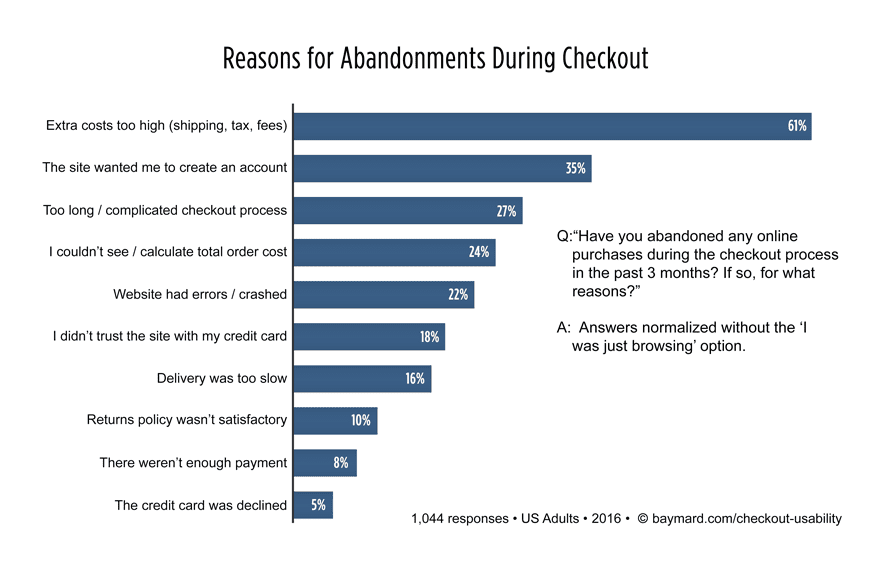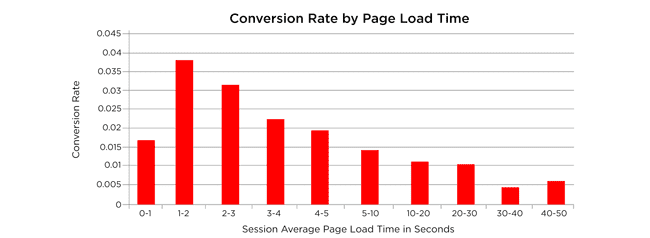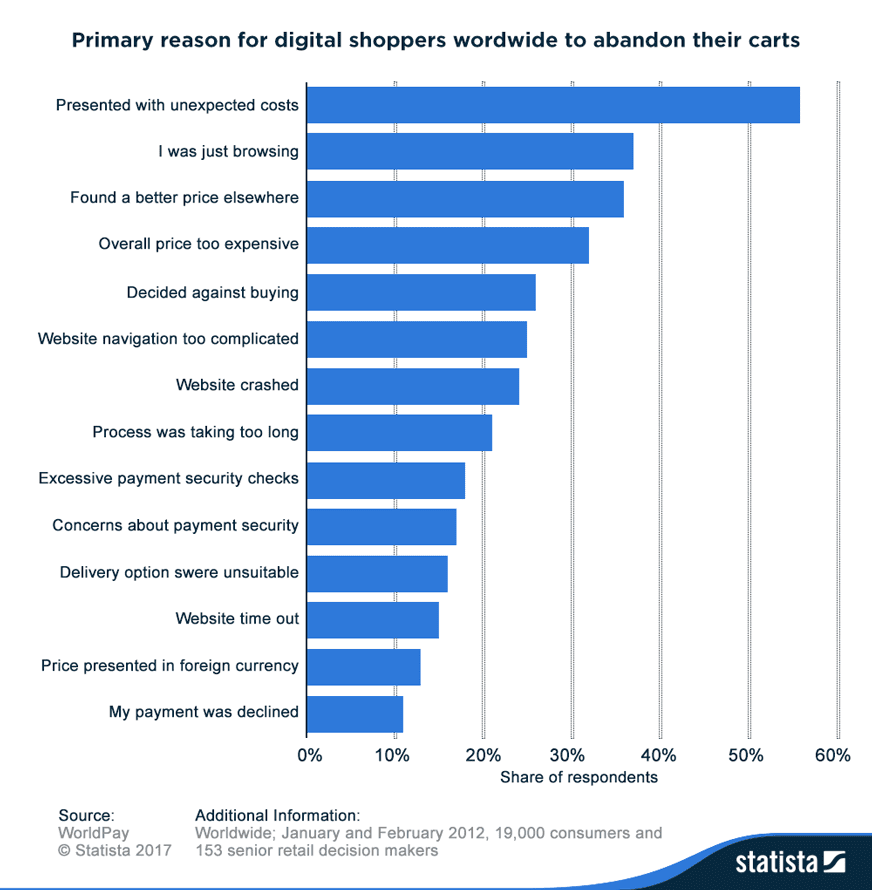$4 Trillion & Counting: 2017 Shopping Cart Abandonment Statistics

In today’s burgeoning ecommerce industry, it’s these cart abandonment rates that impact the bottom line of retailers the most. That’s because they represent lost opportunity; another chance at the sale that could have been. Moreover, abandoners also factor into the bottom line because it means that another segment of marketing dollars has gone to waste on a consumer that could have converted into a paying customer but that didn’t, for whatever reason (and there are many).
We’ll examine more closely this multi-trillion-dollar ecommerce conundrum that’s preventing an industry – one that eMarketer estimates is currently hauling in $2 trillion per year ($4 trillion per year by 2020) – from doubling in size. Here are all the 2017 statistics about cart abandonment that you need to know now, so you can make the right changes to your online store and start securing more sales.
The $4 Trillion Shopping Cart Challenge
As we mentioned above, retailers are getting handed their butts when it comes to current rates of cart abandonment. Telling of this is a Q3 2016 PYMNTS.com report that reveals the shocking amount being lost during the checkout process from consumers who change their minds after adding one or more items to the cart and bounce away. The report cites that in 2014 alone, consumers left $4 trillion in merchandise in shopping carts. By device, the cart abandonment statistics from the report show that desktop has a 61% abandonment rate, tablets have a 71% abandonment rate, and mobile has an 81% abandonment rate.
Notably, the issue at hand is that retailers are making shoppers perform too many tedious tasks, which often leads to them ultimately abandoning the cart before closing on the sale.
 “Four of the top five reasons users are bailing out of the checkout process stem from the logistics of entering information through desktop or mobile. Only one reason, the shipping costs, actually had to do with price,” explains Business Insider in a related report. “This shows that ecommerce retailers are coming up short with regard to the checkout process. Lengthy or complicated checkout forms, such as entering shipping addresses or payment information, account for approximately 39 percent of U.S. cart abandonments.”
“Four of the top five reasons users are bailing out of the checkout process stem from the logistics of entering information through desktop or mobile. Only one reason, the shipping costs, actually had to do with price,” explains Business Insider in a related report. “This shows that ecommerce retailers are coming up short with regard to the checkout process. Lengthy or complicated checkout forms, such as entering shipping addresses or payment information, account for approximately 39 percent of U.S. cart abandonments.”
Timing is a Factor
If around half of cart abandonment reasons are related to the time and tasks required during the checkout process by consumers, the simplest solution that retailers can implement is to speed things up.
In our previous report, “Faster Online Checkouts = More Conversions,” we explain that slow website speed can result in 7% fewer conversions. So the first place retailers will want to test when reducing shopping cart abandonment is their website speed because:
- A slow website can result in abandonment rates as high as 75%.
- 47% of shoppers want your site pages to load in two seconds or less.
- Loyalty drops by 50% when site speed is too slow.
- 64% of shoppers won’t return if your site takes too long to load.
- A three-second loading time results in a 40% bounce or abandonment rate.

Why Shoppers Abandon the Cart
Aside from site loading time and slow checkouts, there are other reasons why shoppers may abandon the cart. While all ecommerce ventures share some common interests, each store really is unique when all is said and done. What may cause customers to abandon a shopping cart at one store may have no impact at another.
A few of the leading ecommerce shopping cart abandonment reasons include:
- 55% due to high shipping prices.
- 35% of stores do not feature a security badge.
- 24% of the time no delivery information is offered.
When culling through various shopping cart abandonment statistics, a few of the dots can be easily connected. When trying to deduce what is causing shoppers to be reluctant to close the deal when they are in the shopping cart, one must examine an online store from top to bottom.

Reducing Shopping Cart Abandonment
Reducing cart abandonment rates doesn’t have a one-size-fits all solution. That’s because no internet retailer store is truly alike. Each store has its own policies, processes, shipping arrangements, inventory suppliers and fulfillment cycles. Whiles stores certainly share some commonalities, the reality is that to reduce the rates of shopping cart abandonment, the individual store needs to be assessed from top to bottom.
- State Shipping Costs: One of the surest ways to decrease cart abandonment rates is by stating the shipping costs upfront and as early during the checkout process as possible. Customers want to know what the cost of shipping is going to be when they are shopping for anything online. You don’t want to risk losing the shopper because they were presented with unexpected costs, which reports say contributes to 56% of cart abandonment.
- Offer Digital Coupons: If you have yet to offer discounts or digital coupons at your online store, the time to consider doing so is now. According to a recent report on mobile coupon statistics and digital coupon usage, over 96% of consumers will shop for a digital coupon before buying a product online. What’s more, a similar study found that over 66 million digital coupons were redeemed by consumers in 2013 alone.
- Add Online Reviews: A related article by Econsultancy finds that 61% of shoppers take the time to read reviews before making a buying decision. In an iPerceptions 2011 report, it was found that 63% of consumers are likelier to make a purchase when customer reviews are available about the product. An eMarketer report found that consumer reviews on a website have 12 times the trust factor as compared to any other review.
- Improve Site Security: Studies have found that 35% of ecommerce websites still don’t show proper security badging or do not have adequate site security in place. An intrinsic element of consumer confidence is found with them feeling that their personal financial information will be safeguarded and secured at the time of checkout. With countless security breach stories sweeping mainstream news, this is a pivotal aspect of reducing cart abandonment rates.
- Make Returns Easy: A variety of studies, polls and surveys have determined, conclusively, that your online product returns policy is directly linked to sales and profits. It’s also an incremental factor in reducing abandonment rates. Consider that 80% of shoppers won’t buy from a store that has a bad return policy, and that 66% read the policy before making a buying decision or abandoning the cart.
2017 Shopping Cart Abandonment Statistics
By taking a look at the most current list of 2017 cart abandonment reasons, retailers can create a game plan that helps them reduce these rates across board. Here’s a definitive list of the most current statistics for your reference.
- 27% of shoppers abandon a cart due to a lengthy checkout process (Baymard).
- 2017 cart abandonment rates are pegged at a whopping 77.25% (Barilliance).
- Shipping prices can reduce 44% of sales and result a 66% abandonment rate (ReadyCloud).
- $4 trillion worth of merchandise is abandoned by shoppers annually (Business Insider).
- 75% of consumers abandon carts but plan to return to the retailer’s site later (SeeWhy).
- The most common cart abandonment hour is from 8-9pm (eConsultancy).
- 44% of shoppers abandon the cart due to the cost of shipping (Forrester).
- Complicated site navigation leads to a 25% cart abandonment rate (Statista).
- Cost of products and timing are two of the top five reasons for abandonment (SeeWhy).
- 63% of consumers are likelier to make a purchase when customer reviews are available about the product (iPerceptions)
- Cart abandonment emails sent within 3 hours result in a 40% open rate (Listrak).
- 88% of shoppers want a positive online shopping experience or they will shop at another store (Why Web Performance Matters).
- 41% of shoppers abandon the cart during the payment stage (Business Insider).
- 13% of shoppers abandon the cart due to payment security concerns (Search Engine Watch).
- 64% of shoppers will leave an online store if loading speed is too slow (Akamai).
- Slow website speed results in at least an 8% increase in abandonment (QuBit).
- For every second your site takes to load, abandonment increases by 7% (Tag Man).
- 54% of shoppers would complete the purchase if a discount was offered at checkout (ClickZ).
- 80% of shoppers want a hassle-free returns policy or they won’t purchase (ReadyCloud).
Stop Abandonment for Good
We leave you with this infographic. It will help you learn what’s causing abandonment at your online store and what measures you can take to stamp it out for good. Start securing more sales today by making these simple fixes.

Share On:







